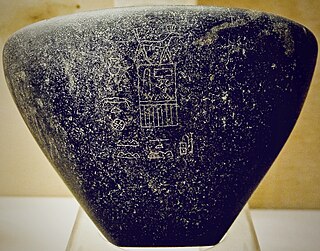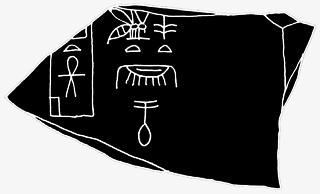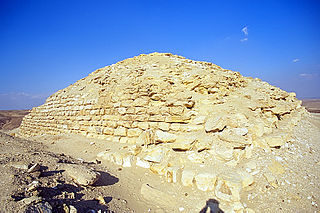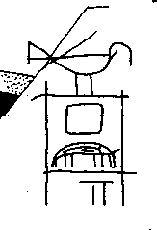
Huni was an ancient Egyptian king and the last pharaoh of the Third Dynasty of Egypt during the Old Kingdom period. Following the Turin king list, he is commonly credited with a reign of 24 years, ending c. 2613 BC.

Scorpion II, also known as King Scorpion, was a ruler during the Protodynastic Period of Upper Egypt.

Iry-Hor was a predynastic pharaoh of Upper Egypt during the 32nd century BC. Excavations at Abydos in the 1980s and 1990s and the discovery in 2012 of an inscription of Iry-Hor in the Sinai confirmed his existence. Iry-Hor is the earliest ruler of Egypt known by name and is sometimes cited as the earliest-living historical person known by name.

Weneg, also known as Weneg-Nebty, is the throne name of an early Egyptian king, who ruled during the Second Dynasty. Although his chronological position is clear to Egyptologists, it is unclear for how long King Weneg ruled. It is also unclear as to which of the archaeologically identified Horus-kings corresponds to Weneg.

Seth-Peribsen is the serekh name of an early Egyptian monarch (pharaoh), who ruled during the Second Dynasty of Egypt. His chronological position within this dynasty is unknown and it is disputed who ruled both before and after him. The duration of his reign is also unknown.

Ka, also (alternatively) Sekhen, was a Predynastic pharaoh of Upper Egypt belonging to Dynasty 0. He probably reigned during the first half of the 32nd century BC. The length of his reign is unknown.

Günter Dreyer was an Egyptologist at the German Archaeological Institute. In southern Egypt, Dreyer discovered records of linen and oil deliveries which have been carbon-dated to between 3300 BCE and 3200 BCE, predating the Dynastic Period.

Neithhotep or Neith-hotep was an ancient Egyptian queen consort living and ruling during the early First Dynasty. She was once thought to be a male ruler: her outstandingly large mastaba and the royal serekh surrounding her name on several seal impressions previously led Egyptologists and historians to the erroneous belief that she might have been an unknown king. As the understanding of early Egyptian writings developed, scholars learned that Neithhotep was in fact a woman of extraordinary rank. She was subsequently considered to be the wife of unified Egypt's first pharaoh, Narmer, and the mother of Hor-Aha.

Nubnefer is the birth name of a king (pharaoh) who may have ruled during the 2nd Dynasty of Ancient Egypt. The exact length of his reign is unknown and his chronological position is unclear.

Ba, also known as Horus Ba, is the serekh-name of an early Egyptian or ancient Egyptian king who may have ruled at the end of the 1st Dynasty, the latter part of 2nd Dynasty or during the 3rd Dynasty. Neither the exact length of his reign nor his chronological position is known.

Horus Bird, also known as Horus-Ba, may have been a pharaoh who may have had a very short reign between the First and Second Dynasty of Egypt. Horus-Bird's burial site is unknown.

Double Falcon was a ruler of Lower Egypt from Naqada III. He may have reigned during the 32nd century BC. The length of his reign is unknown.

The Sayala Mace or Seyala Mace is a ceremonial mace made of gold plated wood and stone, from Predynastic Egypt. It was found by Cecil Mallaby Firth in 1910–11 at Sayala in Lower Nubia and subsequently kept in the Egyptian Museum in Cairo until it was stolen in 1920. Its later fate is unknown. The mace is especially significant for the detailed depictions of animals on its handle.
The pyramid of Elephantine is part of a group of seven very similar small step pyramids, along with the pyramids at Edfu South, el-Kula, Naqada, Saujet el-Meitin, Seila, and Sinki. All of these were built far from the main centres of Egypt and are very poorly understood. The pyramid of Elephantine is located in the northwest part of the Old Kingdom city on the south end of the island of Elephantine in the Nile. The structure was discovered in 1907, but it could only be identified as a pyramid after excavations by the German Archaeological Institute in 1978–79.
The Edfu South pyramid is part of a group of seven very similar small step pyramids which were all built far from the main centres of Egypt and about which very little is known, along with the pyramids of Elephantine, el-Kula, Naqada, Saujet el-Meitin, Sinki and Seila. It is located about five kilometres south of Edfu near Naga el-Ghoneimeya. It was first identified as a pyramid in 1979, when the German archaeologists Günter Dreyer and Werner Kaiser were leading a survey of Edfu after a tip off from the inspector. Further investigation and surveys of the surrounding area have been undertaken since 2010 by the Oriental Institute of the University of Chicago.
The pyramid of Naqada, also called the pyramid of Ombos, is part of a group of seven very similar small step pyramids, which were all erected far from the major centres of Egypt and about which very little is known. It is located about 300 metres north of the ruins of the ancient site of Ombos, near the modern city of Naqada in Upper Egypt. The first excavation was undertaken in 1895 by Flinders Petrie and James Edward Quibell.
Hedju Hor was a ruler in northern Egypt from the Predynastic Period. His existence is controversial. The name Hedju-Hor means The maces of Horus.

Ny-Hor was a possible pharaoh from the Predynastic Period. His name means "The Hunter" according to egyptologist Werner Kaiser. He may have ruled during the 31st century BC.
Bull or Taurus is the provisional name for a predynastic ruler, the existence of whom is highly controversial. He is considered a ruler of the late pottery neolithic Naqada III culture of southern Egypt.

The pyramid of Seila is one of a group of seven small step pyramids which are very similar to one another, along with the Edfu South pyramid, the pyramid of Elephantine, the pyramid of El-Kula, the pyramid of Naqada, the pyramid of Saujet el-Meitin, and the pyramid of Sinki. These pyramids were all built far from the major centres of Egypt and very little is known about them. The pyramid is located on an outcrop between the Faiyum Oasis and the Nile Valley, about 6 km north of the motorway from Wasta to Faiyum. Its builder may have been Snefru, the founder of the Fourth Dynasty. It was discovered in 1889/1890 by Flinders Petrie and revisited in 1898 by Ludwig Borchardt.
















